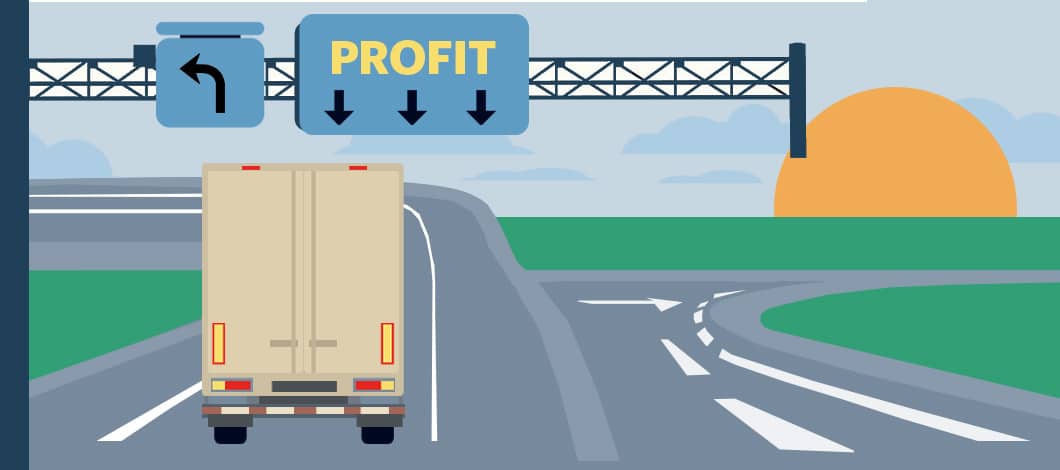Is the trucking business profitable? The short answer is yes. After all, the latest data from American Trucking Associations shows annual revenue of gross freight stands at $875.5 billion nationwide. But how does that translate for you?
Let’s look at the industry’s current outlook and review how trucking companies make money and what trucking profit margins look like.
Plus, discover 10 tips for how to make money in the trucking industry yourself.
How Trucking Companies Make Money
Profit margin in transport business operations centers around shipping velocity, explains logistics expert Damon Langley, co-owner and managing director of Velocity Transportation Solutions, speaking to trucking news site Commercial Carrier Journal. The more freight you can deliver per unit of time while keeping your costs down, the more money you can make.
You can express this idea mathematically by using key performance indicators (KPIs) which measure velocities driving your revenue, such as:
- Miles per driver per week
- Pay per driver per week as a percentage of company revenue
- Revenue per hour generated by customer service representatives soliciting freight
- Revenue per total planned transit time organized by load planners, who are responsible for maximizing driver miles and minimizing time spent driving without freight (deadhead time) or stopped (dwell time)
- Estimated arrival time and projected time available organized by driver managers, who link customers to drivers and provide information to load planners
- Revenue per hour per customer
Planning how you will manage these key metrics to increase your revenue and lower your costs is key to maintaining a strong trucking company profit margin. To help you monitor and manage these KPIs, you can use software designed for the trucking industry, known as transportation management solutions (TMS), such as Trimble Reveal.

How Much Do Trucking Companies Make?
According to trucking company Cargo Transport Alliance, how much fleet owners make per truck each week ranges from an average gross of $5,000-$7,000 or more. An owner-operator who owns a company and manages operations can earn a take-home pay of $2,000-$5,000 a week, while an investor can earn a profit of $500-$2,000 or more per truck each week.
Job posting companies offer slightly different estimates. How much can you make owning a trucking company averages just over $255,000 per year, according to Indeed’s data. In contrast, ZipRecruiter lists the national average salary of owner-operator truck drivers as roughly $242,000 annually.
These figures are subject to variables, such as:
- Type of trucking operation, such as dry vans (which are enclosed and carry loose freight, pallets and boxes) versus flatbeds (which aren’t enclosed and can carry oversized or wide-load items) versus refrigerated vans (reefers)
- Mileage
- Frequency of days not delivering
- Driver efficiency
- Vehicle maintenance costs
- Seasonal conditions
- Market conditions
Is Trucking a Good Business to Start?
It could be a good idea to start a trucking business, but you have to go into it with your eyes open.
For instance, one factor affecting profitability is that in recent years, prices have dropped, but driver pay and contract rates have remained high, cutting into profit margins. Additionally, driver shortages and rising fuel costs present other potential obstacles to success.
That said, while there is risk for trucking startups, there is opportunity, especially for companies that develop a solid financial plan, assess the competition and strategize with profits in mind.
Need a loan for your trucking business?
How to Make Money in the Trucking Industry in 10 Steps
If you take on the challenge of running a trucking company, you need a solid business plan to help you overcome any obstacles you might face. Here are 10 tips to help you steer a course toward profitability.
1. Select a Profitable Market Niche
When starting out as a small trucking business, you stand the best chance of turning a profit if you choose a specialized market niche where you’re not competing directly with large, established trucking companies. Choosing your niche also forms a critical financial planning step because it will determine what services you offer, what equipment you buy and what rates you charge.
For example, the dry van market can be more competitive because of the number of large companies and owner-operators who already have shares in this space. On the other hand, hauling fresh produce and meat can be a profitable niche because there is less competition, less seasonal fluctuation in demand and less risk of economic disruptions to the market, as people always need food.
2. Estimate Operating Costs Accurately
Before you can develop a profitable financial plan, you need to know what your expenses will be to know how much revenue you need to generate to turn a profit and how high you need to set your prices. Your expenses divide into fixed costs and variable costs.
Fixed costs include items that don’t fluctuate significantly over time, such as:
- Payments on vehicles
- Vehicle registration fees
- Trailer registration fees
- Property payments
- Vehicle insurance payments
- Permit fees
- Driver salaries
- Health insurance
Variable fees can change based on your shipping volume and other factors. They include:
- Fuel
- Tolls
- Lodging
- Meals
- Vehicle maintenance and repairs
- Driver wages for drivers paid by the mile
As a rule of thumb, driver compensation and fuel will be your highest costs. A good financing strategy should seek to minimize fuel expenses while maximizing the number of revenue drivers generate per mile and per week. This calls for a smart fueling strategy combined with operational efficiency and careful financial planning.
3. Cut Costs with a Smart Fueling Strategy
To cut your fueling costs, consider the total cost of fuel after taxes are factored in. Tax on fuel in the trucking industry in the lower 48 states and Canadian provinces is governed by the International Fuel Tax Agreement (IFTA).
IFTA simplifies fuel tax reporting for trucks that operate in multiple jurisdictions rather than requiring you to report separately for each jurisdiction. Each vehicle fleet must apply for an IFTA license with what is known as your base jurisdiction.
Your base jurisdiction is where you have:
- Qualified vehicles registered
- Some travel
- Operational control and records maintained (or where they can be made available)
As you buy fuel, your taxes go toward an account. Each quarter, you must file a report with your base jurisdiction totaling all the miles you traveled and all the fuel you purchased in all participating jurisdictions. This is used to calculate the tax you owe each jurisdiction. Any tax you owe or refunds you are owed are then paid to the base jurisdiction, which then handles distributing money to or collecting money from other jurisdictions.
What this means for fuel pricing is that your taxes aren’t determined by pump prices in the state where you bought fuel but by your base fuel cost, which is the price of your fuel at the pump minus your per-gallon state tax. As often as possible, try to refuel in states and at pumps where prices are lowest. While prices may not vary much between states and pumps, over thousands of miles, little differences add up.
Owner-operator trucking software provider Rigbooks offers a state-by-state guide to buying fuel.

4. Develop Direct Relations with Shippers
Difficulty finding shipping loads can cause a trucking company to go out of business, so a good strategy for finding shippers needs to be part of your business plan. Trucking companies often find shippers indirectly by going through middlemen called freight brokers or by using online postings called load boards. While these services are useful, they also charge a fee, cutting into your profits.
To maximize your profit margin, develop your direct relations with shippers. You can pocket the markup fee you would normally pay a broker or use the difference to offer more competitive prices and promote repeat business.
5. Use an Efficient Dispatching System
Dispatching services offer another way to find loads. Dispatching services also can help you assign loads to drivers, manage drivers, manage issues with shippers and customers, handle billing and maintain compliance. If you don’t use a dispatching service for these tasks, you’ll need to develop a system for handling them through your own office.
An efficient dispatching system can allow you to handle more loads at a lower cost, while a poor one can kill your business quickly. If you decide to hire a dispatching service, do your due diligence by asking for recommendations, studying reviews and reviewing details of contracts so you understand all services and pricing involved. If you do your own dispatching, you can increase efficiency by using TMS software with dispatching capability, such as ITS Dispatch.
6. Check Customer Credit
Whether you’re dealing with shippers or brokers, selecting customers who have a good credit rating is prudent to reduce your risk of not getting paid. Use a credit check service to review prospective customer business credit scores before committing to a new client.
7. Automate Billing Procedures
Automating your billing process can save you time and money on labor while reducing the risk of your fees not getting collected on time. Some TMS systems, such as TruckLogics, include automated billing features. You can get standalone invoicing software or use accounting software that includes invoicing features or add-ons.
8. Use Automated Compliance Software
Compliance is another area where automation can increase your efficiency. Regulatory fines for truckers can be expensive, but keeping up with all the paperwork you need to file can be a chore. Use a TMS solution that includes compliance features, or invest in a compliance management solution such as Compliance Safety Manager.
9. Price Services Profitably
As to whether trucking is a profitable business, well, this part is key.
After you’ve considered expenses such as fuel, driver compensation, broker arrangements and software, you’re in a better position to estimate how high you need to price your services in order to turn a profit. To develop a competitive yet profitable price, you need to determine what other carriers charge.
To do this:
- Select a freight lane to use for comparing prices
- Visit load boards and call brokers to find out average prices for shipping in one direction.
- Add a markup of 10%-15% of what brokers charge. Use the same process to determine fees for the other direction.
10. Plan Your Cash Flow to Sustain Profits
Keeping your trucking operations running requires careful cash-flow planning. Payments from shippers and brokers are typically delayed for 15, 30 or 45 days. You need a cash-flow management strategy to ensure you have enough financing available to keep operations running as you’re waiting for payments to come in.
One strategy you can employ is to use your unpaid invoices as collateral to obtain a loan or line of credit, a financing method known as invoice financing. Another useful financing method is equipment financing, which allows you to use equipment you purchase or lease as collateral. These and other methods of small business financing can help you sustain the cash flow you need to keep your trucking business running.
Trucking Industry Outlook
According to Avery Vise, vice president of trucking of FTR | Transportation Intelligence, carrier market conditions are expected to be mildly negative throughout 2023. However, Vise states: “Trucking companies that managed their businesses well during the good times should remain healthy and outperform those that had relied on a robust market to remain afloat.”
Additionally, the need for trucking professionals is expected to rise as the demand for goods increases, according to the U.S. Bureau of Labor Statistics (BLS). That said, current factors affecting growth include the cost of capital as interest rates rise, changes to diesel pricing and weaker freight rates.
While 72% of employers are experiencing difficulty finding drivers, according to Commercial Carrier Journal, the BLS notes the job outlook for heavy and tractor-trailer truck drivers is set to grow 4% from 2021-2031. This is about as fast as the average for all occupations, with 259,900 openings projected each year throughout the decade.
Can the Trucking Business Be Profitable for You?
Ultimately, running a profitable trucking company requires careful planning centered around sound financial management. Additionally, niche selection, cost-cutting strategies, pricing and cash-flow planning are important in maintaining a profitable trucking business.
If you require financing to fuel your trucking business, take a few minutes to fill out our online application and discover your loan options fast.










